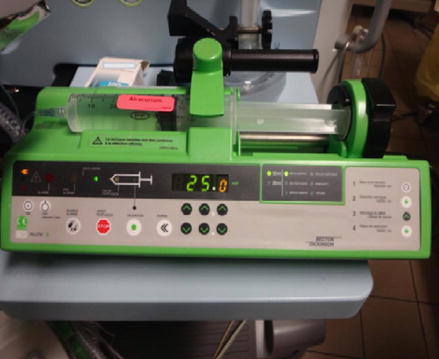Figure 3.1
Non-invasive monitoring of vital parameters
The induction is done only in the presence of the Surgeon. In Nice University Hospital it is performed according to the Target-Controlled Intravenous anesthesia (TCI) technique (or AIVOC in French: Anesthésie Intra-Veineuse à Objectif de Concentration). The technique involves the use of an electrical syringe with a computer-controlled administration rate, according to an accurate calculation based on patient’s weight, age, height, and sex. Drugs commonly used by TCI technique are: Propofol (Diprivan®) 2.5 to 6 μg/ml (cerebral target) and Sufentanil (Sufenta®) 0.2 to 0.5 ng/ml (cerebral target) (Fig. 3.2). A prophylactic antibiotic is given on induction and consists of a second generation cephalosporin: Cefazolin 2 g or Cefuroxime 1.5 g single dose.


Figure 3.2
Target-Controlled Intravenous anesthesia (TCI) technique
Curarisation is achieved by giving a 0.5 mg/Kg Atracurium besylate bolus. When enough curarisation depth is reached as shown in a special monitor, maintenance is obtained with 0.3–0.5 mg/Kg/h (Fig. 3.3).


Figure 3.3
Curarisation pump
Ventilation is delivered with the aid of a mask aiming an Oxygen FiO2 of 100 % (Fig. 3.4).


Figure 3.4
Patient ventilated with the aid of a mask
Once curarisation and TCI targets are achieved, the patient is intubated and ventilated (Fig. 3.5).


Figure 3.5
Patient intubated and ventilated
A vitamin A solution is instillated on the corneas and the eye-lids are occluded with a tape.
At this time a second peripheral line is inserted for security purpose, in order to anticipate any intraoperative surgical complication (bleeding etc.), the first perfusion line being reserved for the TCI drugs administration. A central venous line is not needed since the patient is not at high risk. An indwelling (generally no 16 French) Foley’s catheter is inserted to keep the urinary bladder empty, as well as an orogastric Ryle’s tube to decompress the stomach.
Stay updated, free articles. Join our Telegram channel

Full access? Get Clinical Tree








